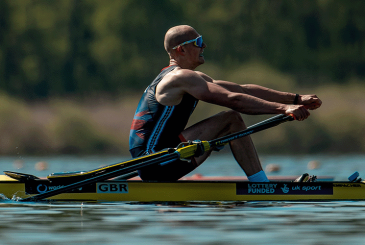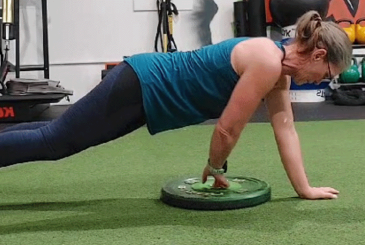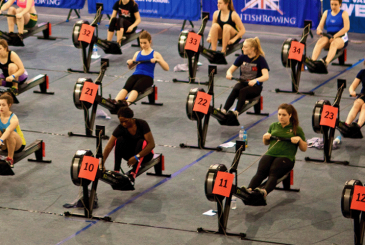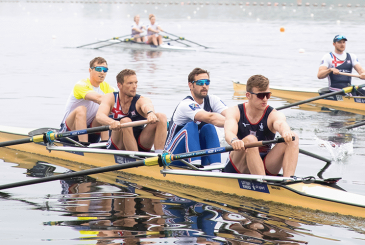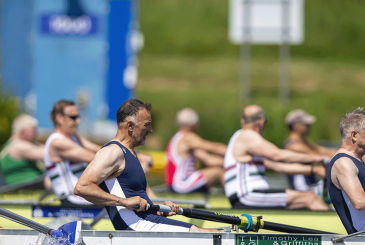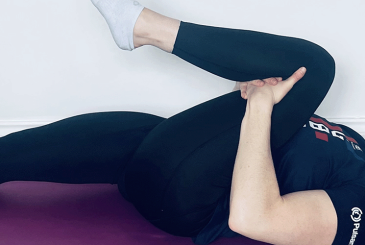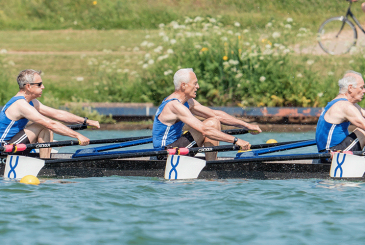This guest post from Science of Rowing summarises an academic study and highlights practical takeaways for coaches and rowers
Citation
Introduction
Lower body strength and power is critical to rowers. It has been estimated that the rowing stroke is 60% legs, 20% trunk, and 20% arms1. Historically, rowing coaches have mainly used the Concept2 rowing ergometer to perform a battery of performance tests. However, the rowing stroke does have a technical component to it and this may not identify athletes’ true athletic potential due to their rowing technique.
There is another way to evaluate physiologically capability and athletic potential. Sport scientists often use the vertical jump to measure several performance variables such as jump height, ground contact time and athlete readiness, and lower body power. It requires minimal set-up and equipment, time, and is easy to implement with large numbers of athletes. Athletes and young children often perform jumps in sport and play, making it a movement that is frequently used. This makes the vertical jump easy to use for testing.
This study explores the relationship between a rowers’ body mass, lower body power, and 1,500m rowing erg performance.
The rowing stroke and vertical jump are both knee and hip driven movements that are full body expressions of strength and power. The comparison between the rowing stroke and the vertical jump is a logical one because both movements are driven by similar muscles. It’s been established that a rower’s body mass is correlated to power in 2,000m rowing ergometer performance2. However, it’s unclear if body mass is also related to the vertical jump as well. This study explores the relationship between a rowers’ body mass, lower body power, and 1,500m rowing erg performance. Rowers and coaches will learn how body mass factors into performance as well as how to develop explosive lower body strength and how we can use the squat jump to do so.
Research question
Are jump height (HSJ), jump index (ISJ)*, and power output (PSJ) in the lower limbs during a squat jump significantly correlated with rowing performance over a 1,500m rowing ergometer time trial? Are these three variables influenced by body mass?
*Jump index (ISJ) is a method to evaluate jump height by multiplying the athlete’s body mass against jump height and gravity.
Participants
14 junior male rowers participated in this study. The rowers were an average age of 15.3 years, 178.6 cm tall (5’10”), and 67.9kg in body mass. All of the rowers participated in the French National Rowing Championships in the previous year and nine participants were medallists. The rowers averaged 3-5 training sessions per week over the two years before this study.
Procedure
The rowers completed the 1,500m rowing ergometer time trial and squat jump testing on two different days. Three days of rest separated the two testing sessions.
1,500m time trial
The 1,500m rowing ergometer time trial was performed at an official French indoor rowing competition. This distance is used in France for rowers in the 15-16 year-old age category. The rowers completed a 30-minute warm-up before the time trial. The researchers recorded the rowers’ 1,500m time trial scores and converted these scores into total seconds. For example, a 5:26 1,500m time trial would be equivalent to 326 seconds. The researchers then calculated the average power output from this time.
Squat jump test
The researchers established a 90 degree knee angle depth for each rower. The rowers then performed a 10-minute warm-up. After the warm-up, the rowers performed a total of three maximal squat jumps (SJs). For each attempt, the rowers lowered to the 90 degree starting height with their hands on their hips. They held this position for two seconds to ensure the athlete was moving from a dead stop and there was no additional downward movement. The researchers then gave the command to jump. The researchers encouraged the rowers to apply force as fast as possible and to jump as high as possible. Upon landing, the rowers had to land and return to the starting position for the repetition to count. There was a one minute rest between each squat jump trial. The researchers used the highest of the three squat jump trials for analysis.
Analysis of squat jump and 1,500m performance
Three different approaches for evaluating squat jump performance are used. The researchers measured the aerial time of the jump using OptoJump which helps to determine vertical jump through flight time and ground contact time using optical sensors. The researchers then used the aerial time to calculate squat jump height (HSJ). Next, the researchers used body mass to calculate the squat jump index (ISJ). Finally, the researchers used a third equation to determine the average power generated by the lower limbs in the squat jump (PSJ). Once the researchers calculated these three variables they were able to determine if there was a correlation between HSJ, ISJ, PSJ, rowing performance and body mass.
Results
The rowers’ body mass was significantly correlated (r2=0.82) with their 1,500m rowing ergometer power output (P1500). The r2 value stands for the Coefficient of Correlation. The value for r2 can range between 0.00 and 1.00, with 1.00 representing a perfect correlation. The rowers’ body mass had an r2 value of 0.82, which shows a strong correlation between body pass and P1500.
PSJ had the strongest correlation to 1,500m rowing ergometer performance and it is significantly correlated with body mass
Rowers’ body mass tended to be correlated (r2=0.27) with HSJ, which shows a weak relationship between these two variables. Next, the researchers determined if there was a relationship between P1500 and the three methods for evaluating the squat jump. The researchers found a weak correlation to HSJ (r2=0.29), moderate correlation to jump index ISJ (r2=0.76), and a significant correlation to PSJ (r2=0.86). This tells us that the method to calculate power output for the lower limbs, PSJ, had the strongest correlation to 1,500m rowing ergometer performance and it is significantly correlated with body mass. Finally, the researchers found that body mass was responsible for 97% of the relationship between P1500 and both HSJ and ISJ. The relationship between body mass was responsible for 96% of the relationship between P1500 and PSJ. This means that a rowers’ weight directly correlates to their lower limb power and 1,500m rowing ergometer performance.
Limitations
The main limitation to this study is that it only included junior male rowers and the time trial distance was 1,500m, which is not the racing distance used at the university, elite, or masters levels. This study should be replicated with female rowers and different competition levels (university, masters, elite) to determine if the correlation holds true at the 2,000m and 1,000m sprint distances. This would show a stronger relationship across multiple age and rowing competition levels.
Additionally, power output (PSJ) was not measured but calculated using a mathematical equation so it is possible the accuracy is limited. Finally, the rowers jumped from a pause, with their hands on their hips, at a 90 degree angle. Without a pause, from a standard jump height, or the use of the arms may affect the results. It would also be helpful to test against other jump variations and conditions to establish these relationships as well.
Takeaways
The main takeaway from this study is that PSJ had the strongest correlation to 1,500m rowing ergometer performance out of the three methods used to calculate squat jump power and jump height.
The authors suggest that one of the reasons why PSJ has the strongest correlation is because the equation used to calculate PSJ is exclusively based on physics, whereas the equations for HSJ and ISJ are strongly influenced by the athletes’ anthropometric characteristics such as sex, age, and physical activity levels. The PSJ equation takes into consideration the lower limb length change from start position to take off. The PSJ equation is actually accounting for how quickly the athlete is jumping off the floor, which explains why it has a stronger relationship compared to HSJ and ISJ.
The second takeaway from this study was the strong relationship between body mass and 1,500m ergometer time trial performance and PSJ.
It makes sense to me that body mass will have a strong relationship with rowing ergometer performance.
Force = mass x acceleration.
A heavier rower who is able to accelerate their body mass more quickly will apply more force to the handle. However, I was a bit surprised to find such a strong correlation between body mass and jump height. We must go back and critically evaluate this sub-population of rowers. These are junior male rowers with an average body weight of under 70kg. It would be very informative to see if this relationship held up with heavier rowers at the university, elite, and masters levels.
The final takeaway would be to include more explosive movements using the lower body to develop strength and power.
Rowers have to prioritize lower body strength to enhance their force capabilities then focus on power development. This study is additional research that shows the value of plyometrics and their development in young junior rowers. The authors of this article propose to focus on some more advanced movements such as the squat jump, drop jump, and countermovement jump. Please see my article, “Improving Rowing Performance Through Concurrent Plyometric Training”, in Volume 1, Issue 3 and you can review my plyometrics tutorial video if you are brand new to this skill. My bonus content will include a video tutorial of the squat jump and advanced progressions.
Practical application
The squat jump will reinforce knee and hip extension which is a key component of the drive phase and lower-body power development. Rowers and coaches can use this explosive exercise to develop strength and power that may transfer over to the rowing stroke. The purpose of the squat jump is to develop lower body power without the use of the stretch-shortening cycle. The stretch-shortening cycle describes the action of the muscle: first a pre-stretch occurs, followed by an isometric transitional period, and then the explosive concentric phase takes place3. So, rowers get the benefit of learning to develop knee and hip extension from a dead stop with external load, like a race start.
The researchers also included drop jumps in their suggestions for rowers. However, the drop jump involves the stretch shortening cycle. I am not including a write up or video tutorial of the drop jump because that plyometric involves a fast-stretch shortening cycle. Recent evidence by Held et al. (2020) suggests the rowing stroke involves a slow stretch-shortening cycle. By focusing on the squat jump, this will allow our strength training program to be much more specific to the sport of rowing4. For a full explanation of the slow and fast-stretch shortening cycle please see my article, “Slow or Fast SSC: What Rowers Need to Train” in Volume 2, Issue 6.
The squat jump
Rowers can perform the squat jump with a barbell or kettlebell. Rowers will begin by patterning the movement with bodyweight only. This will build off the plyometrics video I created in Volume 1, Issue Once athletes progress to load there are some considerations to be aware of. First, the total load should be between 10-50% of the athlete’s body mass5. Second, when performing the squat jump it is critical that a pause is used. The pause will allow the stretch-shortening cycle to dissipate and ensure the athlete is executing the squat jump from a dead stop. Rowers should descend to the bottom of the squat, hold a pause for 2-3 seconds, then perform a vertical jump5. They can vary the depth of their squat jump to work on strength and explosiveness throughout different ranges of motion.
Rowers often perform drills and start work at 1⁄2 slide or 3⁄4 slide in the boat. This is another opportunity to develop power and control at different ranges of motion.
Barbell squat jump set-up and execution
Most barbells weigh 20kg and are fixed at this weight. A 90kg male rower would be at 22.5% of their body weight with the barbell alone. Adding two 10kg plates to the barbell would put that athlete at approximately 47.5% of their body weight, just under the recommended upper limit. Athletes are encouraged to start on the lower end of the 10-50% weight range and build up slowly. Remember, these are power exercises and are to be performed with maximal intent. They will also be fatiguing because of the 2-3 second pause at the bottom of the squat.
I recommend athletes set-up the barbell in a high bar position. This means the bar will rest across the top of the shoulder blades and trapezius muscles. Athletes will unrack the barbell, step back, and descend to depth, pause for three seconds, then perform a vertical jump. Athletes must emphasize full extension of the hips and knees and plantar flex their feet as well. Upon landing, athletes should absorb the force as quickly as possible aiming to return to the start position.
Kettlebell squat jump set-up and execution
Kettlebells can be found in kilograms or pounds and the weights for each bell size move in much smaller increments compared to a barbell. For example, kettlebells typically jump 4kg per bell. The only downside is you would need more kettlebells at various weights. The upside is that it’s much easier to start with a lighter load using the kettlebell than the barbell. Athletes will deadlift the kettlebell up and then flip it upside down so the handle is pointed towards the ground and the base of the bell is pointed towards the ceiling. Next, lift the bell to eye level and rotate it behind your head so the bell rests against the top of your shoulder blades. You will then descend to depth, pause for 2-3 seconds, and then perform a vertical jump.
Cluster sets
The best way to maximize safety and power output is to keep the reps per set low and very explosive. Cluster sets are a great way to achieve this for any power exercise. Athletes can perform 2-3 reps then rest for 30 seconds, and then perform an additional 2-3 reps, followed by 2-5 minutes of rest. Athletes will stay fresh and be able to really go at a high-intensity using this type of programming structure. Below is a chart with a breakdown for different sets and rep schemes using cluster sets.
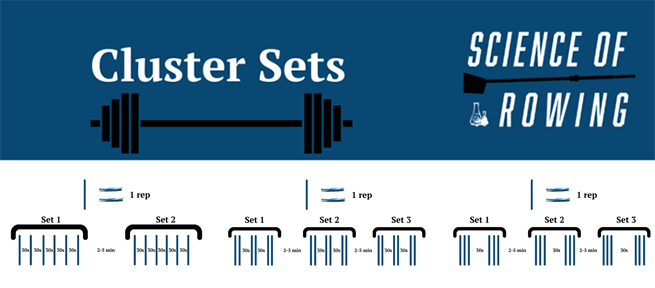
Bonus content
Drop squat review
Barbell squat jump
Kettlebell squat jump
Want to read more articles like this?
This review is just one of over 130 now available at Science of Rowing, with more added every month. The reviews covers all things rowing from physiology, strength training and injury management to technique and biomechanics.
All British Rowing members can get to a 20% discount on Science of Rowing subscriptions! To get your code, just log in to the British Rowing Membership system, then go to Member Details>Member Benefits.
References
[1] Concept2 https://www.concept2.com/news/rowing-leg-sport-0
[2] Bourdin, M., Messonnier, L., Hager, J., & Lacour, J. (2004). Peak power output predicts rowing ergometer performance in elite male rowers. International Journal of Sports Medicine, 25(5).
[3] Turner, A. N., & Jeffreys, I. (2010). The stretch-shortening cycle: Proposed mechanisms and methods for enhancement. Strength & Conditioning Journal,32(4).
[4] Held, S., Siebert, T., & Donath, L. (2020). Electromyographic activity of the vastus medialis and gastrocnemius implicates a slow stretch-shortening cycle during rowing in the field. Scientific Reports, 10(1).
[5] McGuigan, M. & National Strength and Conditioning Association (2017). Developing Power Human Kinetics.
Disclaimer
The recommendations in this publication are not medical guidelines but are for educational purposes only. The authors strongly recommend that you consult with your physician before beginning any exercise program. You should be in good physical condition and be able to participate in any sort of exercise. The authors are not licensed healthcare care providers and represents that they have no expertise in diagnosing, examining, or treating medical conditions of any kind, or in determining the effect of any specific exercise on a medical condition.
You should understand that when participating in any exercise or exercise program, there is the possibility of physical injury. If you engage in exercises from this publication, you agree that you do so at your own risk, are voluntarily participating in these activities, assume all risk of injury to yourself, and agree to release and discharge the publisher and the authors from any and all claims or causes of action, known or unknown, arising out of the contents of this publication. The authors advise you to take full responsibility for your safety and know your limits. Before practicing the skills described in this book, be sure that your equipment is well maintained and do not take risks beyond your level of experience, aptitude, training, and comfort level.
The recommendations in this publication are not intended as a substitute for any exercise routine, treatment, or dietary regiment that may have been prescribed by your physician. Don’t lift heavy weights if you are alone, inexperienced, injured, or fatigued. Don’t perform any exercise without proper instruction. Always perform a warm-up before all forms of training.



